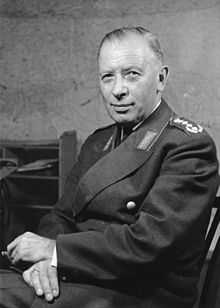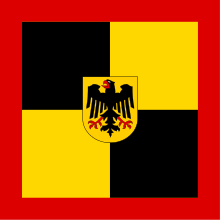Adolf Heusinger
| Adolf Heusinger | |
|---|---|
 | |
| Born |
August 4, 1897 Holzminden, Brunswick, German Empire |
| Died |
November 30, 1982 (aged 85) Cologne |
| Allegiance |
|
| Years of service | 1915–1945, 1955–1964 |
| Rank | General |
| Awards |
Iron Cross (1914) 1st Class |
General Adolf Heusinger (August 4, 1897 – November 30, 1982) was a German general officer who briefly served as Chief of the General Staff of the Army during World War II and served as the first Inspector General of the Bundeswehr, the West German armed forces, from 1957 to 1961. Heusinger served as Chairman of the NATO Military Committee from 1961 to 1964.
Biography
Early years
Heusinger was born in Holzminden, in the Duchy of Brunswick, German Empire. He entered the Imperial German Army on June 17, 1915, and was assigned to 7. Thüringisches Infanterie-Regiment Nr. 96, an infantry regiment raised in the Thuringia region of Germany (including the Reuss principalities). He was promoted to Ensign (Fähnrich) on March 31, 1916, and was commissioned a second lieutenant on July 4, 1917. He was wounded several times in combat at Verdun and in Flanders, and was taken prisoner by the British on July 31, 1917. During World War I, he was decorated with the Prussian Iron Cross 2nd Class and Iron Cross 1st Class, Brunswick's War Merit Cross 2nd Class, the Reuss Silver Merit Medal with Swords, the Reuss Honor Cross 3rd Class with Swords and the Wound Badge in Black.
After World War I, and upon being freed from British captivity, Heusinger returned to Germany and entered the Reichswehr, the small 100,000-man army Germany was permitted to keep under the Treaty of Versailles. He entered the Reichswehr on New Year's Day 1920 as a second lieutenant in the 15th Infantry Regiment, based in Kassel. From 1927 to 1930 he was enrolled in the leadership assistant course . He served in a variety of infantry and staff assignments until October 1931, when he was assigned to the operations staff of the Troop Office (Truppenamt) in the Reichswehr Ministry (Reichswehrministerium). The Troop Office acted as the German Army's General Staff during the Weimar Republic era, as the Treaty of Versailles also forbade that institution. Promotions were slow in the small Reichswehr; Heusinger was promoted to first lieutenant (Oberleutnant) in April 1925 and a captain (Hauptmann) on October 1, 1932.
Heusinger served in Berlin with the Troop Office until August 1934, and then returned to troop assignments. He was made chief operations officer of the 11th Division in October 1935, where he served until August 1937. In the meantime he was promoted to major on March 16, 1936. With the rise of the Nazis in Germany and Adolf Hitler's assumption of power, the restrictions of the Treaty of Versailles were ended and the German General Staff was officially reestablished. In August 1937, Heusinger was assigned to the Operations Staff (Operationsabteilung) of the Army General Staff as a general staff officer. He served there, being promoted to lieutenant colonel on March 20, 1939, and remained in that position until October 15, 1940, when he became its chief.
World War II
With the outbreak of the Second World War, the German Army High Command (Oberkommando des Heeres, or OKH) assumed its wartime organization. Heusinger accompanied the field staff and assisted in the planning of operations in Poland, Denmark, Norway, and France and the Low Countries. He was promoted to colonel on August 1, 1940 and, as noted above, became chief of the Operationsabteilung in October 1940, making him number three in the Army planning hierarchy, after the Chief of the General Staff, General Franz Halder, and the Deputy Chief of the General Staff/Chief Quartermaster (Oberquartiermeister I), General Friedrich Paulus.
After the invasion of the Soviet Union in June 1941, the OKH became primarily responsible for planning operations in that theater, while the Armed Forces High Command (Oberkommando der Wehrmacht, or OKW) was responsible for other theaters. Halder was replaced as Chief of the General Staff in September 1942 by General Kurt Zeitzler. Paulus left the OKH in December 1941 and was succeeded in January 1942 by General Günther Blumentritt, who held the Oberquartiermeister I position until September 1942 when it was abolished.
Heusinger remained chief of the Operationsabteilung and was promoted to Generalmajor (major general) on January 1, 1942 and to Generalleutnant (lieutenant general) on January 1, 1943.[1] In June 1944, General Zeitzler became ill, and on June 10, Heusinger temporarily assumed his office as Chief of the General Staff of the Army. In this capacity, he attended the meeting at Adolf Hitler's "Wolf's Lair" on July 20, 1944 and was standing next to Hitler when the bomb planted by Colonel Claus von Stauffenberg exploded.
Heusinger was hospitalized for his injuries in the explosion, and was arrested and interrogated by the Gestapo to determine his role, if any, in the July Plot. Although there was evidence that Heusinger had contact with many of the conspirators, there was insufficient evidence to directly connect him to the plot, and he was freed in October 1944. However, he was placed into the "Führer-Reserve" and was not assigned to another position until March 25, 1945, when he was made chief of armed forces mapping matters (Chef Wehrmacht-Kartenwesen). He was taken prisoner by the Western Allies in May 1945.
Post-World War II
A prisoner of war from 1945 to 1947, Heusinger testified during the Nuremberg Trials.
According to documents released by the Bundesnachrichtendienst in 2014, Heusinger may have been part of the Schnez-Truppe, a secret army that veterans of the Wehrmacht and Waffen-SS established up from 1949.[2]
In 1950, he became an advisor on military matters to Konrad Adenauer, the Chancellor of West Germany. He served in Amt Blank, the office headed by Theodor Blank which became the West German Ministry of Defense in 1955.
With the establishment of the Bundeswehr in 1955, Heusinger returned to military service. He was appointed a Generalleutnant (lieutenant general) on November 12, 1955.[3] in the Bundeswehr and chairman of the Military Leadership Council (Militärischer Führungsrat).
In March 1957, he succeeded Hans Speidel as chief of the Bundeswehr's all-armed forces department (Chef der Abteilung Gesamtstreitkräfte).
Shortly thereafter, in June 1957, Heusinger was promoted to full general and named the first Inspector General of the Bundeswehr (Generalinspekteur der Bundeswehr), and served in that capacity until March 1961. In April 1961, he was appointed Chairman of the NATO Military Committee in Washington, D.C., where he served until 1964, when he retired. He was according to news reports, wanted by the Russians in the early 1960s in respect of organizing the Koriukivka massacre.
Heusinger died in Cologne on November 30, 1982.
Portrayal in the media
In the 2004 German production, Stauffenberg, Heusinger is portrayed by actor Ludwig Boettger.
Awards and decorations
- Iron Cross (1914) 1st and 2nd Class
- Wound Badge 1918 in Black
- Iron Cross (1939) 1st and 2nd Class
- Princely Reuss Honour Cross 3rd Class with Swords
- Princely Reuss Silver Merit Medal with Swords
- War Merit Cross 2nd Class (Brunswick)
- Honour Cross of the World War 1914/1918 (World War I service medal)
- Wound Badge of 20 July 1944 in silver
- War Merit Cross (1939), 1st and 2nd Class with Swords
- Wehrmacht Long Service Award, 2nd Class
- Large Merit Cross of the Merit Order of the Federal Republic of Germany with Star and Sash
- Commanders of the United States Legion of Merit
- Commander's Cross of the Order of the Crown of Italy
- Commander's Cross of the Order of Merit of Hungary
- Order of the Cross of Liberty 1st Class with Swords (Finland)
References
- ↑ Until 1945, the German Army general officer ranks of major-general and lieutenant-general were equivalent to one-star (brigadier or brigadier general) and two-star (major general) ranks, respectively.
- ↑ Wiegrefe, Klaus, "Files Uncovered: Nazi veterans Created Illegal Army", Spiegel Online, 14 May 2014
- ↑ This was actually a promotion from his Wehrmacht rank of Generalleutnant. Until 1945, the German Army general officer ranks of Generalmajor (major-general) and Generalleutnant (lieutenant-general) were equivalent to one-star (brigadier or brigadier general) and two-star (major general) ranks, respectively. The Bundeswehr uses a NATO-standardized rank structure, with addition of the one-star rank of Brigadegeneral and Generalleutnant the equivalent to three-star rank in the British and American armies.
External links
- Searle, Alaric. Wehrmacht Generals, West German Society, and the Debate on Rearmament, 1949–1959, Praeger Pub., 2003.
- http://www.bmvg.de/portal/a/bmvg/ministerium/geschichte_bmvg/generalinspekteure_bw?yw_contentURL=/C1256F1200608B1B/W26FBCU8233INFODE/content.jsp
- http://www.geocities.com/~orion47/WEHRMACHT/HEER/Generalleutnant/HEUSINGER_ADOLF.html (Archived 2009-10-24)
- http://www.dhm.de/lemo/html/biografien/HeusingerAdolf/
| ||||||||
| |||||||||||
|
